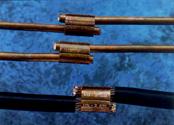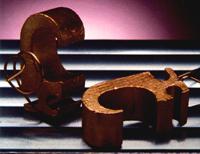Copper Alloys Favored for Connectors
 A new power connector from Thomas & Betts is made of C11000.
A new power connector from Thomas & Betts is made of C11000.Wherever electricity flows, connectors are required. And copper in many varieties remains the dominant and favored material from which the world's connectors are made. As one enthusiast, Gene Pecora, put it, "If I had my druthers, I'd only use copper alloys. Copper is a very forgiving material." Pecora is director of engineering for Framatome Connectors/ Burndy Electrical, a leading supplier of high-power connectors in Manchester, New Hampshire.
Connectors are made in vast and ever-increasing number in two major categories: electrical and electronic. The former conduct strong currents, while the latter conduct weaker, or "signal" currents, and include the important telecommunications area.
The most commonly used coppers in Framatome connectors are high-conductivity C10200, C10300, C11000 and C12000. Where strength is needed, Pecora favors a bronze, C95400. Some Framatome connectors weigh as much as 20 pounds.
In contrast to such massive connectors, electronic connectors may weigh as little as a few milligrams with spacing between pins less than a half millimeter. Because conductivity is not as critical in electronic connectors, they are made of a different group of copper alloys. At Molex, Inc., a major manufacturer located in Lisle, Illinois, the most commonly used alloy is C51000, a tin bronze (also known as phosphor bronze). Dr. Robert Malucci, Molex's director of reliability, uses the phosphor bronzes for many applications because they stress-relax less as operating temperatures increase. That is, they tend not to lose their springiness or contact force over time. Beryllium coppers, such as C17200 and C17410, are often used for the same reason.
 At 20 pounds, this is one of the largest connectors made, from Framatome. High-conductivity copper is used extensively in power connectors.
At 20 pounds, this is one of the largest connectors made, from Framatome. High-conductivity copper is used extensively in power connectors.A copper-nickel-silicon alloy, C70260, is also finding growing use in electronic connectors. It offers excellent stress relaxation characteristics and reasonably good conductivity and is available in thin gauges, averaging 0.014 inches.
At Thomas & Betts, Inc., a leading producer of electrical connectors in Memphis, C11000 is favored for its high electrical and high thermal conductivity. According to BlLL Barton, engineering manager, Termination Products, C11000 also offers "excellent cold working characteristics." This is important in field installation, where connectors made of C11000 are often clamped mto place with hydraulic tools that resemble giant pliers.
Barton also reports extensive use of C12000, which has good brazing characteristics.
U.S. Is World Leader In Connectors
The United States is the leader in the world's multi-billion-dollar connector industry. According to Ken Fleck, Fleck Research, Santa Ana, California, double-digit growth percentages in sales of PCs, work stations and networks should sustain the current high demand for electronic connectors. Fleck sees telecommuting as contributing to expanded sales of PCs. He says there are now more than 40 million U.S. home offices. By the year 2000, the number of PCs' installed worldwide is expected to exceed 700 million.
At the same time, data traffic over phone lines is growing 30% a year, Fleck notes. The market for connectors in communications should also grow rapidly as cable systems for delivery of TV become more common in the developed nations. For example, of 325 million households with TV in Asia, only 4% have cable, compared to 61% in the U.S.
Detroit is also becoming an increasingly important market for connectors because of more and more electronic and electrical equipment in vehicles. To meet this need, Molex's automotive connectors provide very high pin counts. All in all, these trends confirm increased demand for electronic connectors, mostly made of copper and its alloys.
Fleck Research: 714/953-9000
Framatomel/Burndy: 800/346-4175
Molex, Inc. 708/969-4550
7'hontas & Betts, Inc. 800/888-0211
Also in this Issue:
- Lead-free Cast Red Brasses for Plumbing
- Copper Alloys Favored for Connectors
- Copper and Brass Make a Silver Ghost!
- Copper Covers U.S. Olympic Training Center
